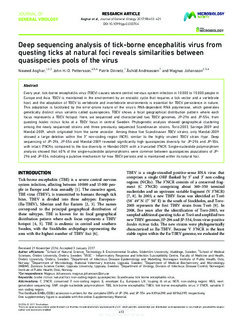| dc.contributor.author | Asghar, Naveed | |
| dc.contributor.author | Pettersson, John | |
| dc.contributor.author | Dinnetz, Patrik | |
| dc.contributor.author | Andreassen, Åshild Kristine | |
| dc.contributor.author | Johansson, Magnus | |
| dc.date.accessioned | 2017-06-28T10:11:01Z | |
| dc.date.available | 2017-06-28T10:11:01Z | |
| dc.date.created | 2017-06-22T09:11:08Z | |
| dc.date.issued | 2017 | |
| dc.identifier.citation | Journal of General Virology. 2017, 98 (3), 413-421. | |
| dc.identifier.issn | 0022-1317 | |
| dc.identifier.uri | http://hdl.handle.net/11250/2447149 | |
| dc.description.abstract | Every year, tick-borne encephalitis virus (TBEV) causes severe central nervous system infection in 10 000 to 15 000 people in Europe and Asia. TBEV is maintained in the environment by an enzootic cycle that requires a tick vector and a vertebrate host, and the adaptation of TBEV to vertebrate and invertebrate environments is essential for TBEV persistence in nature. This adaptation is facilitated by the error-prone nature of the virus's RNA-dependent RNA polymerase, which generates genetically distinct virus variants called quasispecies. TBEV shows a focal geographical distribution pattern where each focus represents a TBEV hotspot. Here, we sequenced and characterized two TBEV genomes, JP-296 and JP-554, from questing Ixodes ricinus ticks at a TBEV focus in central Sweden. Phylogenetic analysis showed geographical clustering among the newly sequenced strains and three previously sequenced Scandinavian strains, Toro-2003, Saringe-2009 and Mandal-2009, which originated from the same ancestor. Among these five Scandinavian TBEV strains, only Mandal-2009 showed a large deletion within the 3' non-coding region (NCR), similar to the highly virulent TBEV strain Hypr. Deep sequencing of JP-296, JP-554 and Mandal-2009 revealed significantly high quasispecies diversity for JP-296 and JP-554, with intact 3' NCRs, compared to the low diversity in Mandal-2009, with a truncated 3' NCR. Single-nucleotide polymorphism analysis showed that 40% of the single-nucleotide polymorphisms were common between quasispecies populations of JP-296 and JP-554, indicating a putative mechanism for how TBEV persists and is maintained within its natural foci. | |
| dc.language.iso | eng | |
| dc.relation.uri | http://www.microbiologyresearch.org/docserver/fulltext/jgv/98/3/413_vir000704.pdf?expires=1498116256&id=id&accname=guest&checksum=AC2B25BD50A150C23B2CEA95C9571DFA | |
| dc.title | Deep sequencing analysis of tick-borne encephalitis virus from questing ticks at natural foci reveals similarities between quasispecies pools of the virus | |
| dc.type | Peer reviewed | |
| dc.type | Journal article | |
| dc.description.version | publishedVersion | |
| dc.source.pagenumber | 413-421 | |
| dc.source.volume | 98 | |
| dc.source.journal | Journal of General Virology | |
| dc.source.issue | 3 | |
| dc.identifier.doi | 10.1099/jgv.0.000704 | |
| dc.identifier.cristin | 1478075 | |
| cristin.unitcode | 7502,4,19,0 | |
| cristin.unitcode | 7502,4,10,0 | |
| cristin.unitname | Infeksjonsepidemiologi og modellering | |
| cristin.unitname | Virologi | |
| cristin.ispublished | true | |
| cristin.fulltext | original | |
| cristin.qualitycode | 1 | |
